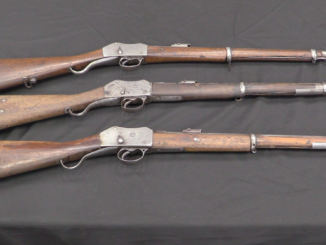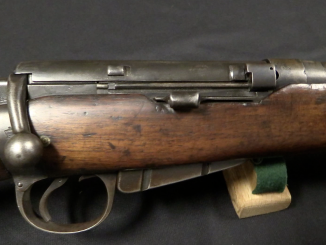Charles Lancaster started his unmaking business in London in 1826, and it would survive more than one hundred years, being run after Charles’ death by his sons and then by an apprentice who bought out the firm in 1878. The company had an excellent reputation for quality, and did some pioneering work on developing the modern breechloading shotgun, as well as interesting technological developments like Lancaster’s oval-bore rifling. One of their most notable products was a series of 2-barrel and 4-barrel handguns, and they expanded the mechanism from those into a small number of 4-barrel shotguns (and an even smaller number of 4-barrel rifles).
This particular four-barrel shotgun is in 20 gauge, and exhibits a unique trigger mechanism derived from the pistols. It has two triggers, with the bottom one acting as a cocking lever and the top as a firing trigger. This allows the shooter to either cock the gun and then make a careful shot with the light upper trigger, or to pull all the way through with the upper trigger, much like a double action revolver. The reason for the system was that the firing mechanism had four firing pins but only one striker, which rotated to fire each barrel in sequence. The “cocking” action of the trigger was in fact the process of retracting the striker and rotating it to the next barrel.




Gorgeous work, at any aspect of it. Very clever trigger mechanism too. When comes to joining barrels it looks like hi-temp silver soldiered. That method is quite common on firearms with one hiccup – it leaves witness line/spill which is hard to mask with conventional finish processes.
What about the double action trigger pull? Is it quite heavy?
Beautiful condition, considering age and usage.
Very nice piece you have there ,this was what I meant in an earlier post that sportsman at one time cared what thier gun looked like to all the world anyone who knows guns knows this gun has class ,it doesn’t look like someone made a gun from a used bumper jack like the AR types flooding to days markets!
The trigger system was called a Tranter trigger, inventor of the same name, available on revolvers before 1860 (some Union civil war officers carried them privately). I am too lazy right now to get up and research the full history of Tranter but I advise all who read here to look him up.
On all of the pictured Tranter handgun triggers I have seen in books, the middle-finger or cocking trigger extended below the trigger guard through a slot and usually folded up for holstering, then dropped free for business. I have read that you squeezed both triggers for self-cocking (British parlance) or double-action, and for fine aiming single-action you squeezed the bottom trigger and then the top as Mr. M demonstrated above. I had not heard of just squeezing the top trigger for self-cocking or double action.
The Tranter system was one of a couple of similar setups at the time. The Savage-North revolver of the American Civil War worked on a similar principle;
https://www.forgottenweapons.com/ria-savage-navy-revolver/
One important difference, however, was that in the Savage-North version, the lower (ring) trigger that rotated the cylinder, and cocked the hammer absolutely had to be drawn back first. If you tried pulling both triggers simultaneously as with the Tranter, it would damage the Savage-North’s rather delicate internal bits.
There’s a tradition that at least one British general didn’t think much of the Tranter, saying that “a man can’t be expected to play a cornet-a-piston with his revolver in a fight”, but I’ve often wondered if it wasn’t the Savage-North that said officer was exercised about.
cheers
eon
We discussed this a few years ago and yes, the Savage revolver was the problem child. I doubt that the British ever used it but perhaps after comparing it to the domestic counterpart the better of the two was chosen. The Tranter didn’t snag on account of the hammer not having a spur. I wonder if having a snag resistant double-trigger double-action gun was better than a single-action ring-cocked gun if one was tangling with half a dozen spear-wielding natives.
Thanks for the Tranter reference!
Awesome 20-ga! Shorn of all its meticulous and lustrous gun-maker’s finesse, we have here Hillberg’s Liberator 4-barrel 16-gauge or 20-gauge break-open shotgun MkII design, no? The MkI used a pop-in cassette holding four pre-loaded chambers, which sensibly gave way to 2-1/2″ shot shells. Intrepid Ian examined the Hillberg Liberator prototypes, including the entirely wrong-headed 12-ga. version marketed to police depts. on one of his visits to the Cody museum in Wyoming.
The trigger mechanism here looks positively superior to any of the examples developed and explored on Hillberg’s Liberator prototypes.
Lancaster must have made very tiny guns to fit them in that can…
+Is there a Patent holding restriction? Why has this fine bit arms not been modernized and in production?
i would put for a bit of money for one of these Four Barrel Marvels.